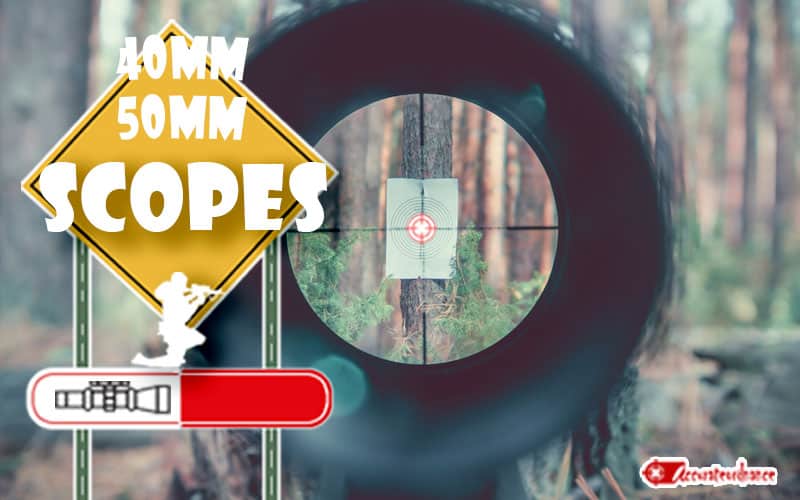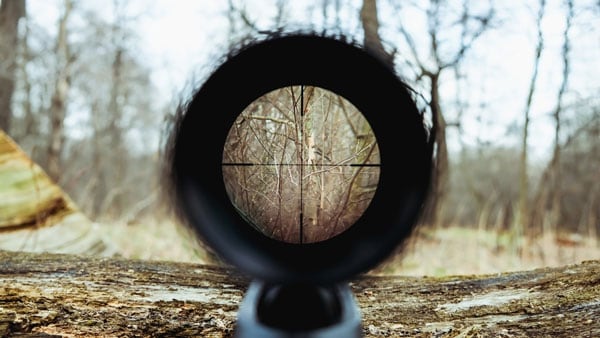Wider diameter rifle scopes are the standard in picture clarity and brightness, especially if you wish to limit the amount of image darkening as magnification increases. 50mm refers to the diameter of the objective lens; a bigger objective lens will result in a brighter, clearer, sharper image.

There are pros and cons to using a 40mm vs 50mm scope, but we’ll concentrate on the major difference and things that matter when choosing between these objective lens diameter sizes.
The diameter of the objective lens of a rifle scope determines the amount of light that can enter through it. A larger objective lens diameter means there would be better light transmission and clearer image quality even in low light or hazy weather.
Furthermore, getting a good glass and high quality glass coating will improve image sharpness.
| – 40mm VS 50mm Major Differences |
| – Exit Pupil Size In Low Light |
| – Weight Consideration |
| – Lens Coating |
| – Scope Glass Quality |
| – Scope Tube Diameter |
| – Rifle Scope Mounting Cheek weld |
| – Rifle Scopes With 40mm Objective Size |
| – Rifle Scopes With 50mm Objective Size . |
The 40mm Objective Lens Vs 50mm Objective Lens: Major Differences
There isn’t much of a difference when you compare a 40mm objective lens scope with a 50mm objective lens scope by looking through them with your naked eye.
A 40mm lens made from a high glass quality and coating may gather and allow more light transmission to the shooter’s eye compared to a 50mm lens with poor glass quality and coating. In other words, objective diameter size is not the only important factor when considering light transmission in a lens.
Exit Pupil Size In Low Light
One of the first questions to ask when comparing a 40mm lens with a 50mm lens is the size of the exit pupil. The exit pupil is that bright circle visible in the center of the eyepiece when a binocular is held about 30cm from your eyes, and the objective lenses are oriented toward a bright light.
A 50mm Objective Lens Scope has a bigger exit pupil when compared to a 40mm objective lens, thereby giving you more flexibility as you move your head and get on target quickly without much scope shadow obstructing your view.
Human pupils have a diameter of between 2-3mm in bright light and a diameter of 7mm in low light. The brightness of the picture seen by the shooter is determined by the size of the exit pupil of the rifle scope at that magnification power.
Weight Consideration
Another factor to consider is the weight of the scope. A 50mm scope usually means additional weight to the rifle scope. A smaller objective lens may be the best option for hunting, especially when you are going on a long trip and you know the magnification you truly need for your type of hunting.
In general, getting a higher performance from a wider scope diameter comes with a cost, and that cost is a heavier weight. Whatever the scope magnification range, a 50mm objective lens scope must weigh more compared to a scope with a 40mm lens.
Furthermore, the wide tapered objective diameter makes installing a sight on some rifles difficult; this would require an increased scope mount height for greater scope clearance.
Lens Coating
A riflescope that has a high-quality lens coating will let more light pass through the lens. A riflescope with a poor coating will reflect light both internally and externally, resulting in lens flare.
When light bounces and reflects in and out of a riflescope, the image quality suffers and appears smeared or blurry. Choosing the best scope between a 40mm and 50mm scope, in this case, is dependent on the quality of the lens coating.
Scope Glass Quality

The glass quality might spell the difference between a brilliant scope and an average scope.
Generally, you get what you pay for when it comes to scope glasses. The clearer the glass, the higher the resolution, and the more costly the scope model. So if you want a 40mm scope that can perform better than a 50mm scope of the same magnification, then you have to consider the quality of the glass.
So How Can You Know Which Are Good?
There are three factors to consider:
- Color
- Clarity
- Brightness
The majority of rifle scopes on the market now are manufactured in other countries. Japanese glass is the best of the best, and it is supplied to Vortex, NightForce, Primary Arms, and other companies.
Scope Tube Diameter
If everything else remains constant, a wider objective lens can give the shooter a brighter image. A widespread myth in the scope world is that a wide objective lens paired with a high tube diameter provides the best picture quality, which is incorrect.
If the glass quality is bad, even a 50mm objective lens with a 30mm tube isn’t necessarily superior to a 40mm scope.
To illustrate this, a high-grade scope like the Vortex Razor HD that has a smaller objective lens produces a brighter and clearer image than an entry-level Vortex Crossfire with a magnification and tube diameter of 3-12X56mm.
For a long range scope, the size of the scope tube allows for additional adjustment clicks.
Rifle Scope Mounting Cheek weld
A higher scope mount is required for a bigger objective lens scope so that:
- The scope would not make contact with the rifle barrel.
- If the riflescope is mounted too low, the barrel harmonics might make contact with it during recoil, causing accuracy issues.
Rifle Scopes With 40mm Objective Size
Here are some rifle scopes with a 40mm lens diameter.
Table Rifle Scopes With a 40mm Lens Diameter:
| x | Lower Magnification | Higher Magnification | Objective lens diameter | Eye Relief |
|---|---|---|---|---|
| BSA Optics Sweet 17 AO 3X-12X 40mm Rifle Scope .17 HMR | 3 | 12 | 40 mm | 3 inches |
| Leupold Mark 3HD 4-12x40mm Side Focus Riflescope | 4 | 12 | 40 mm | 3.7 inche |
| Leupold VX-Freedom 3-9x40mm Riflescope | 3 | 9 | 40 mm | 3.7 inche |
Rifle Scopes With 50mm Objective Size
Table Rifle Scopes With a 50 mm Lens Diameter:
| x | Lower Magnification | Higher Magnification | Objective lens diameter | Eye Relief |
|---|---|---|---|---|
| Vortex Optics Viper HS LR Second Focal Plane Riflescopes | 4 | 16 | 50 mm | 4.0 inches |
| EOTECH Vudu 5-25x50mm Precision Rifle Scope | 5 | 25 | 50 mm | 3.7 inche |
| Burris Xtreme Tactical XTR II 4-20x50mm Precision Rifle Scope | 4 | 20 | 50 mm | 4.2 inche |
After you’ve decided on the type of objective lens that will best meet your hunting goals and budget, you need to know a little more about the subject.
Note that the optical quality of a rifle scope is more important than the objective size. A scope with a medium objective lens and superb, pure, high-end glass will perform better than a scope with a big objective lens and low glass quality. Likewise, vice versa.

Mike Hardesty is a published freelance gun writer. He also possesses specialized expertise in rifle scopes With dozens of articles and reviews published in Pew Pew Tactical, Snipercountry.com, and TTAG (The Truth About Guns), Mike is considered a firearms expert. His special area of expertise is handguns.
Mike is a long-time shooter. He has been punching paper targets, taking deer and other game and shooting at competitions since about 1975. Other related pursuits include reloading and bullet casting. He currently reloads for over 10 calibers, both handgun and rifle. His reloads, particularly for 9mm, were in great demand during the height of the ammo shortage among family and friends. He donated hundreds of rounds to informal shooting sessions. He was quoted as saying “I do not sell my reloads but I sure will help my guys shoot ’em for free!”. He has a few cherished firearms that he has inherited or otherwise procured — those are his favorites.
He earned B.S. and M.S. degrees from Indiana State University in 1974-1975.
He’s a firearm experts and is the founder of mhardesty.com.
